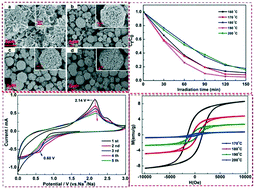The synthesis of FeCoS2 and an insight into its physicochemical performance†
Abstract
In this work, FeCoS2 was synthesised via a modulated hydrothermal method. With the hydrothermal temperature being increased, the microstructure of the as-obtained FeCoS2 evolved from the initial ultrathin nanosheets to the final microspheres, which were also assembled from these nanosheets. Meanwhile, X-ray diffraction results illustrated that the degree of the [101] preferred orientation was gradually reduced with increasing hydrothermal temperature. When being evaluated as a photocatalyst toward the photodegradation of methylene blue, FeCoS2 presented itself as a promising candidate for the photocatalytic degradation. When the as-obtained FeCoS2 was tested as an anode material for Na-ion batteries, it could deliver a first discharge capacity of 806 mA h g−1 at 50 mA g−1. In addition, the magnetic properties of the temperature-dependent FeCoS2 products were also investigated, demonstrating that FeCoS2 nanosheets obtained at 170 °C exhibited the most evident ferromagnetic characteristics. The current research illustrates FeCoS2's potential for diverse applications in modern materials science and devices.



 Please wait while we load your content...
Please wait while we load your content...